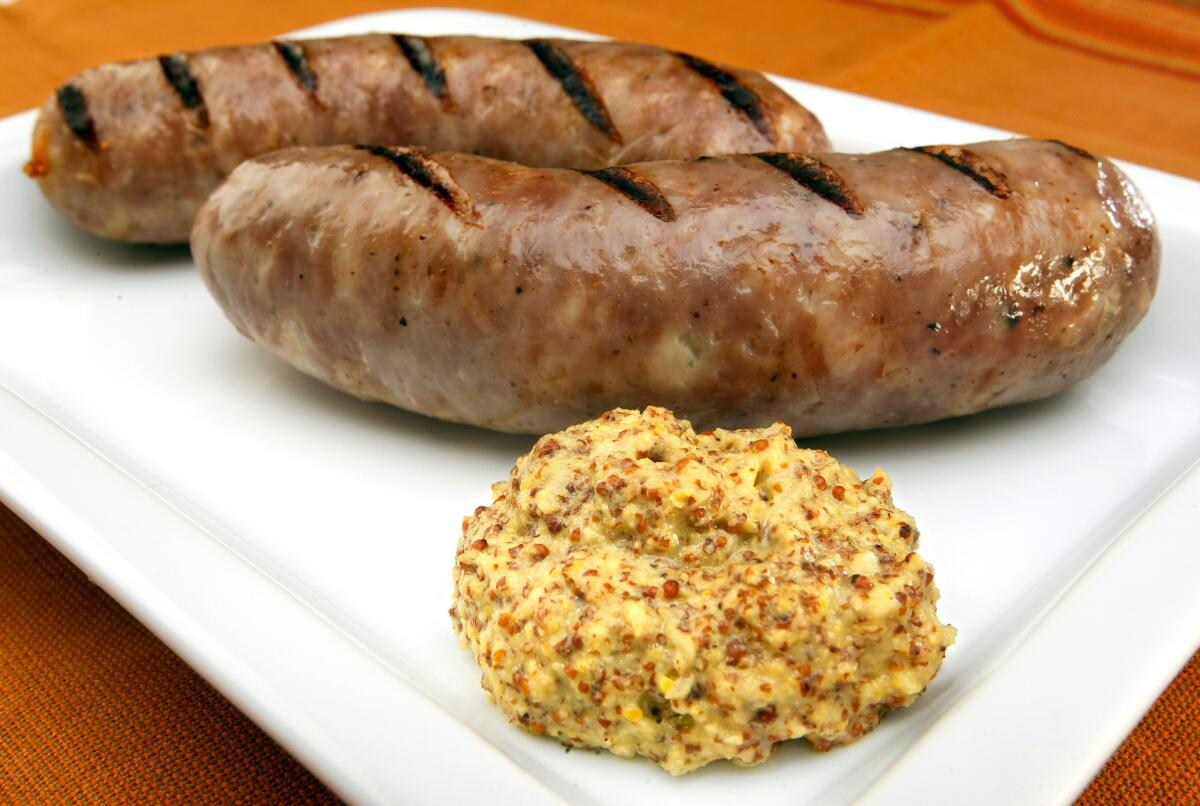DIY mustard, with 5 recipes

Chopped apple lends sweetness and texture.
Recipe: Hard cider mustard
- Share via
Consider mustard, and you probably think first of the bright yellow stuff you get in a squeeze bottle. Or maybe you prefer something a little less mild, a favorite brand of Dijon or a spicy whole grain. But have you ever tried making mustard from scratch? It’s a lot easier than you’d think.
Essentially, mustard is a combination of seeds and liquid. First you soak seeds in your choice of water, vinegar — maybe a double bock beer — until they’re softened, then flavor the mix as desired and grind the seeds. Ta-da: homemade mustard. You can even start the whole process with powdered mustard instead of whole seeds, which makes it even easier.
Mustard is also a condiment that lends itself to experimentation. Sweeten or spice the flavors, manipulate the texture and fine-tune it to create your own custom spread. Done right, mustard is downright magical, whether fancy or not.
If you use seeds, there are three types to choose from: black, brown and white (sometimes called yellow), each with varying degrees of heat, or pungency. White and brown seeds can be found at most markets; black is a little tougher but can generally be found in Indian markets and fine cooking stores. (You can find everything online.) The trick is learning to manipulate the pungency. You can make mustard with one type of seed (or powder) or go for a blend to vary the pungency.
Before grinding the seeds, they should be soaked in liquid — enough to submerge them. Depending on the seeds’ age, they may absorb more or less liquid over a day or two, expanding as they soften. The choice of liquid can also make a difference in determining the heat of the mustard. Vinegar and water are basic; water gives the mustard a cleaner, brighter heat than vinegar, though vinegar lends a wonderful tang. Or try wine, fruit juice or your favorite beer.
When adding the liquid, consider temperature. Mustard’s punch will dissipate with heat; adding a warm or hot liquid, or cooking the mustard (some recipes are thickened with egg), can dull the flavor. To maximize pungency, use a cold liquid.
Then decide on the additional flavors. A mustard can be as simple as a basic Chinese mustard, where ground powder is mixed with cold water to form a fiery fresh paste. Or it can be complicated, to give the mustard more depth. Sweeten the mustard, maybe with brown sugar or honey. Layer it with spices — a touch of cumin for an earthy note, or caraway if you’re using a beer as a liquid. Add some fresh or dried herbs to brighten the mustard. Fruit or nuts are a less common but wonderful addition to the condiment.
Once the seeds are softened, they’ll grind easily. A number of recipes call for grinding dry seeds before soaking, but the seeds can be tough and difficult, giving your arm more of a workout than you might expect. Grind the moistened seeds in a food processor, then strain the mustard for a smooth, more refined product, or leave the hulls in the mustard for a more rustic texture.
Finally, give the mustard time to age. Patience is definitely a virtue here. When you first make the mustard, the flavors can be harsh and bitter. Aging the mustard will give the flavors time to combine and mellow.
Once you’ve perfected it, you’ll want to make a larger batch to share. Check out these recipes for inspiration. And for more information, check out this interview on The Splendid Table.
Love cooking as much as I do? Follow me @noellecarter
More to Read
Eat your way across L.A.
Get our weekly Tasting Notes newsletter for reviews, news and more.
You may occasionally receive promotional content from the Los Angeles Times.











